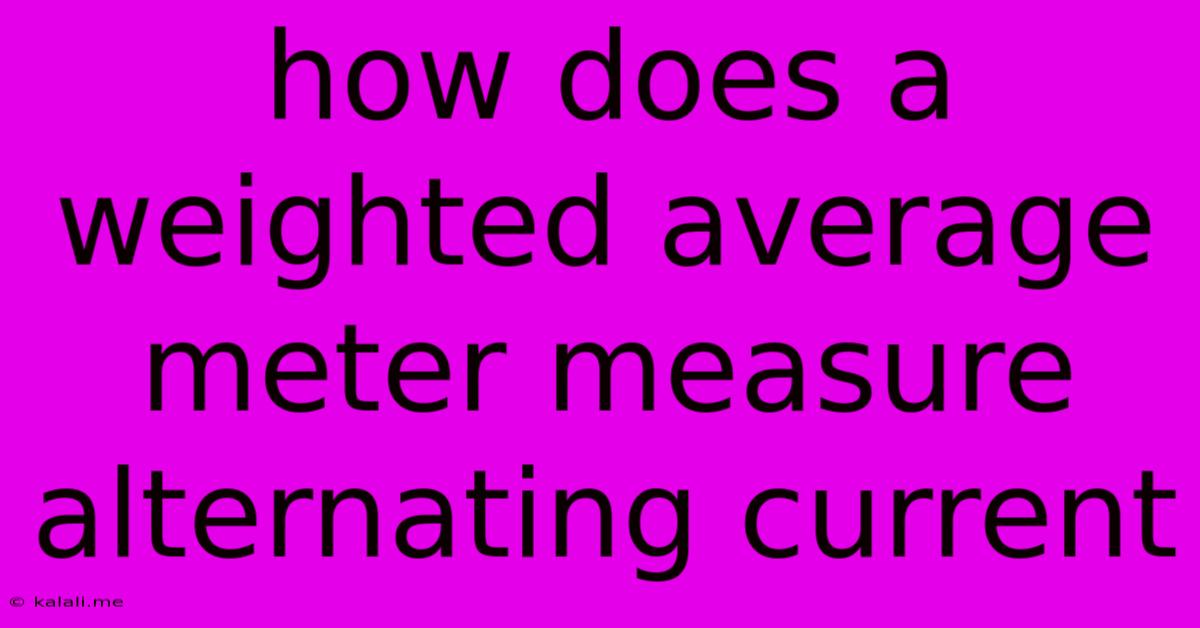How Does A Weighted Average Meter Measure Alternating Current
Kalali
May 09, 2025 · 3 min read

Table of Contents
How Does a Weighted Average Meter Measure Alternating Current?
Measuring alternating current (AC) accurately is crucial in various applications, from household electricity monitoring to industrial power management. Unlike direct current (DC), which flows consistently in one direction, AC constantly changes direction and magnitude. This fluctuating nature necessitates specialized measurement techniques, and one common approach utilizes a weighted average meter. This article delves into the mechanics of how these meters precisely quantify AC current despite its dynamic nature.
A weighted average meter, also known as a true RMS (Root Mean Square) meter, doesn't simply calculate the average value of the AC waveform. The average of a typical AC sine wave is zero because the positive and negative half-cycles cancel each other out. Instead, a true RMS meter calculates the square root of the mean of the squares of the instantaneous values of the AC waveform. This sophisticated approach accurately reflects the heating effect of the current, providing a measurement more aligned with the actual power delivered.
Here's a breakdown of the process:
1. Sampling the Waveform
The meter first samples the AC waveform at regular intervals. The frequency of these samples depends on the meter's design and the expected frequency of the AC signal. More frequent sampling generally leads to greater accuracy, particularly for complex waveforms that deviate significantly from a pure sine wave. This sampling process transforms the continuous analog signal into a discrete digital representation.
2. Squaring the Samples
Each sampled value is then squared. This crucial step eliminates the negative values, preventing cancellation effects that would occur with a simple averaging method. Squaring the values ensures that all contributions to the heating effect are considered, regardless of direction.
3. Averaging the Squared Samples
The squared samples are averaged to obtain the mean square value. This step involves summing all the squared values and then dividing by the number of samples. This provides a measure of the average power dissipation.
4. Taking the Square Root
Finally, the square root of the mean square value is calculated. This delivers the root mean square (RMS) value of the AC current, which represents the equivalent DC current that would produce the same heating effect. This RMS value is the measurement displayed by the meter.
Advantages of Weighted Average (True RMS) Measurement
- Accuracy: Provides a more accurate representation of the AC current's heating effect compared to simple average methods. This is especially critical for non-sinusoidal waveforms, such as those found in many modern electronic devices.
- Real-World Applicability: The RMS value accurately reflects the power delivered by the AC current, making it essential for power calculations and circuit analysis.
- Compatibility: True RMS meters are compatible with a wide range of AC waveforms, including sine waves, square waves, and complex waveforms containing harmonics.
Distinguishing True RMS from Average-Responding Meters
It's essential to distinguish between true RMS meters and average-responding meters. Average-responding meters only provide accurate readings for pure sinusoidal waveforms. They significantly underestimate the actual current for non-sinusoidal waveforms, leading to potential inaccuracies in power calculations and safety concerns. Always use a true RMS meter for accurate and reliable AC current measurement, especially when dealing with potentially complex or distorted waveforms.
In conclusion, a weighted average meter, or true RMS meter, utilizes a sophisticated mathematical process to accurately measure AC current despite its constantly changing direction and magnitude. This process involves sampling, squaring, averaging, and taking the square root, resulting in a value that represents the equivalent DC current's heating effect. This makes it an invaluable tool for a broad range of electrical measurement applications.
Latest Posts
Latest Posts
-
Formation Of A Secondary Oocyte Occurs During
May 09, 2025
-
How Much Is 200ml In Ounces
May 09, 2025
-
Least Common Multiple Of 4 And 18
May 09, 2025
-
Which Is A Property Of Acids In Aqueous Solutions
May 09, 2025
-
What Is 15 Out Of 18 As A Percentage
May 09, 2025
Related Post
Thank you for visiting our website which covers about How Does A Weighted Average Meter Measure Alternating Current . We hope the information provided has been useful to you. Feel free to contact us if you have any questions or need further assistance. See you next time and don't miss to bookmark.